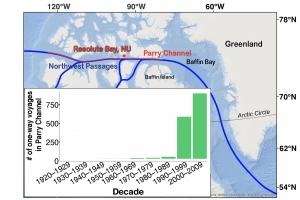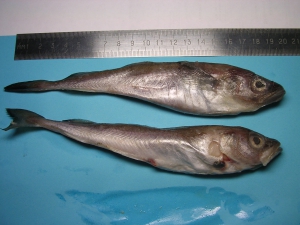I can hear you: the effects of shipping on the behavior of Arctic cod (Boreogadus saida)
By: Victor Bach Muñoz
When people think about noise in the ocean, they may think about negative effects on species that are known to be vocal in popular culture, like cetaceans (Ellison et al. 2012). However, whales and dolphins are not the only species affected by the increasingly abundant anthropogenic marine noises, as studies on fish have previously demonstrated (Simpson et al. 2016). Much of this marine noise comes from boat traffic, which quadrupled in only two decades at the beginning of the century, raising concerns among scientists about how marine communities may be affected (Tournadre 2014). However, until now, the Artic marine habitats had remained relatively spared by the this increase in shipping activities, mainly due to the Arctic’s sea ice cover. However, climate change has been severely affecting the Arctic sea ice extent during summer months, reducing it by 49% from the 1979 to 2000 baseline average in 2012 (Overland & Wang 2013). This phenomenon is now opening greater boat traffic opportunities through the Northwest Passages, including the Parry Channel (Figure 1).

Figure 1: Map of the Northwest Passage routes and location of Resolute Bay, Nunavut, Canada (Source: Ivanova et al. 2012)
In 2012, Ivanova et al. conducted a study in Resolute Bay, Canada, to find out if sound from ships was influencing the movement patterns of an important polar species: the Arctic cod (Boreogadus saida). The researchers recorded the sound produced by the different types of ships traveling through the bay and tagged 85 Arctic cods (Figure 2) with acoustic transmitters (although only 77 where ultimately used to obtain data). Acoustic receivers in the bay where then used to triangulate the position of the tagged fish as the experiment unfolded, resulting in 11.852 detections between the months of July and September. The movements of Arctic cods where then compared to several variables including ship noise but also marine mammal presence, daily dissolved oxygen, water temperature, salinity, wind speed and wind direction. The results showed that the fish were having a negative response to the noise produced by ships, relocating to other parts of the bay away from those. Furthermore, the potential behavioral changes for the species could have extended ramifications to the many polar inhabitants that depend on it, from seabirds and toothed whales to all Arctic indigenous people.

Figure 2: Two Arctic cods (Boreogadus saida), also known as polar or boreal cods (Photo by Wikifranki from the Creative Commons)
As our planet’s ecosystems keep being affected by climate change, mankind is likely going to look for ways to make the best out of a bad situation. However, while the retreat of Arctic sea ice may offer new possibilities for shipping through the Northwest Passages, it is important to consider the impact that those newly more abundant human activities could have on those relatively pristine environments. While we navigate the surface in look for progress, the underwater communities that provide food and life are listening to our uproar, and it may be just too loud for them.
Work cited:
Ellison, W. T., Southall, B. L., Clark, C. W., & Frankel, A. S. (2012). A new context‐based approach to assess marine mammal behavioral responses to anthropogenic sounds. Conservation Biology, 26(1), 21-28.
Ivanova, S. V., Kessel, S. T., Espinoza, M., McLean, M. F., O’Neill, C., Landry, J., … & Fisk, A. T. (2019) Shipping alters the movement and behavior of Arctic cod (Boreogadus saida), a keystone fish in Arctic marine ecosystems. Ecological Applications, e02050.
Overland, J. E., & Wang, M. (2013). When will the summer Arctic be nearly sea ice free?. Geophysical Research Letters, 40(10), 2097-2101.
Simpson, S. D., Radford, A. N., Nedelec, S. L., Ferrari, M. C., Chivers, D. P., McCormick, M. I., & Meekan, M. G. (2016). Anthropogenic noise increases fish mortality by predation. Nature communications, 7, 10544.
Tournadre, J. (2014). Anthropogenic pressure on the open ocean: The growth of ship traffic revealed by altimeter data analysis. Geophysical Research Letters, 41(22), 7924-7932.
